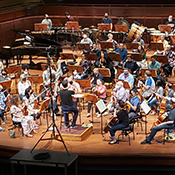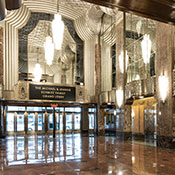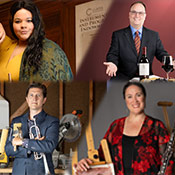
Sculpture Milwaukee at the Bradley Symphony Center
David Lewellen
PUBLISHED
Tagged Under: Bradley Symphony Center, Partners
The newly installed sculpture on the ground floor of the Bradley Symphony Center represents one more way for the Milwaukee Symphony to integrate itself into the community.
Molten Drawing, a work by Christine Tarkowski will occupy the space at the corner of Wisconsin Avenue and Second Street for the next year or so. It was placed there by Sculpture Milwaukee, a non-profit organization which annually transforms downtown Milwaukee’s cultural landscape with an outdoor exhibition of world-renowned sculpture.
Sculpture Milwaukee was the vision of Steve Marcus, former CEO of the Marcus Corp., which donated the Warner Grand Theater to the MSO to be its future home four years ago. “Steve Marcus wants to keep our downtown thriving and vibrant, and give people more reasons to visit,” said Meg Strobel, director of marketing and community engagement for Sculpture Milwaukee.
Part of that vision is that the art works should be accessible to the public at all times. Molten Drawing is too fragile to be displayed outdoors, but “in a beautiful glass building, it’s accessible 24 hours,” Strobel said. “It’s a safe, pandemic-proof cultural experience.”
“This is our first installation on the other side of the public space,” said Michelle Grabner, a well-known Wisconsin-based artist who co-curated this year’s Sculpture Milwaukee exhibit, along with renowned artist Theaster Gates. Behind the glass wall of the MSO’s atrium, the sculpture “changes from the day to the evening hours. It pulls in not only Christine’s work but the new building as well.”
When the new building was designed, that corner was intended to be “almost a display case on its own,” said MSO Executive Director Mark Niehaus. Historic preservation rules required the building’s main entrance to remain through the ornate doors into the former theater, but that meant that the showcase corner could be reserved for another purpose. “This sculpture would have been in the middle of the street a few years ago,” he said, referring to the relocation of the historic back wall of the building, which narrowed Second Street considerably.
And sitting in that glass display case now is a sculpture created by pouring molten glass and molten copper over a steel framework. “It’s reflected and brittle and hard and beautiful,” Grabner said. “It’s both delicate and strong.”
Now, a few weeks after the sculpture was installed, “people stop all day long,” Niehaus said. “A lot of them go around the corner to get a better look. Everyone walks up to it and reads the plaque. People gather at the window and peek in, especially at night.”
If a space created for music installs a piece of visual art, it invites reflection on how the two forms relate to each other. “I’ve found aspects of music can be translated to this piece,” Grabner said. “Where do you see discord, or strength and beauty?”
“I call myself a sculptor, but I work in a real variety of mediums,” said Tarkowski, a Chicago-based artist who had done a lot of work in textiles before taking up molten glass several years ago. “Now a lot of what I do is on an architectural scale.” Speaking of Molten Drawing, she said, “I’ve never done anything like that, before or after. I was thinking about how I could wrangle glass in such a way that it would never be the same line twice. I wanted to see if copper and glass would be compatible. It’s physics and chemistry and quasi-alchemy.”
The cooled drips of glass may look random, but “I know a lot of what’s going to happen,” she said. “There is a design to it, if I pour at a certain temperature, or move my hand a certain way.”
Tarkowski installed the piece in the Bradley Symphony Center gallery herself, with some elements hanging from the ceiling and some on tables. She created the hanging pieces in the air, she said, including one piece with a flat bottom that flowed to the bottom of the kiln. “It confounds you,” she said. “You think it should be resting on something, but the majority of it was drawn in the air.”
“As a person who spends a lot of time on Wisconsin Avenue, I was so excited when we found that the Milwaukee Symphony would be right on our principal exhibit route,” said Strobel, the Sculpture Milwaukee representative. “We’re so grateful, and they’ve been great partners.”



